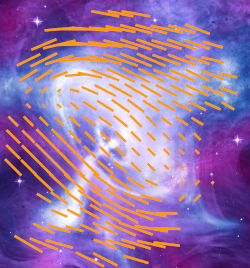HEAPOW: The Curl of the Crab (2023 Jun 26)
Posted: Mon Jun 26, 2023 9:59 pm
 The Curl of the Crab
The Curl of the Crab
The Crab Nebula is an extended cloud of hot gas produced by the total explosion of a hot, massive star which was observed in 1054 A. D. (but which occurred nearly 2000 years earlier). At the heart of the nebula lies the Crab pulsar, the bright point near the center of the image above. The pulsar is a rapidly spinning neutron star, the remains of the core of the star that exploded crushed to the density of an atomic nucleus. The Crab pulsar spins more than 30 times per second, generating flashes of X-ray, optical and radio waves. The image above is a composite image of the nebula, showing X-ray emission (measured by the Chandra X-ray Observatory in blue and white), an optical image from the Hubble Space Telescope (purple), and an infrared image obtained by the Spitzer Space Telescope (pink). The orange lines represent the direction of the magnetic field in the nebula measured by the Imaging X-ray Polarization Explorer (IXPE). IXPE measures the polarization, or the net orientation, of X-ray light waves imprinted on the emission when the X-ray emitting matter interacts with the magnetic field in the nebula. IXPE polarization measurements show that the magnetic field in the nebula is toroidal in shape, like a donut, with large spatial variations of undetermined origin. While the pulsed emission is largely unpolarized, IXPE surprisingly shows that the emission seen during the main peak is significantly polarized, inconsistent with current emission models.
IXPE: Historic Nebula Seen Like Never Before
viewtopic.php?t=43048
| << Previous HEAPOW | High Energy Astrophysics Picture of the Week | Next HEAPOW >> |